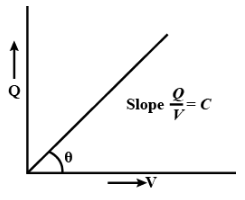
Answer
395.1k+ views
Hint: The ratio of the amount of electric charge deposited on a conductor to the difference in electric potential is known as capacitance. Self-capacitance and reciprocal capacitance are two closely related concepts of capacitance. Self-capacitance is a property of any material that can be electrically charged.
Complete answer:
The electric potential difference between the target and the ground is determined in this situation. At a given potential difference, a substance with a high self capacitance carries more electric charge than one with a low capacitance. Knowledge of the action of the capacitor, one of the three basic linear electronic elements, requires an understanding of mutual capacitance (along with resistors and inductors).
The following is the relationship between the potential through the plates and the charge on the capacitor. As a result, we can see that V is proportional to $Q$. As a result, the graph must be a straight line from the origin with a positive slope.
$Q = C V$
It is of the form
$y=mx$
Here, $m=C$
$Q \propto V$

The graph between $V$ and $Q$ is initially a straight line. However, after a certain point, charge leakage begins, and $V$ does not rise as $Q$ increases. The below figure depicts this difference.

Note: Two conductors, one positively charged and the other negatively charged, are used to divide electric charge in a typical capacitor, but the circuit has a cumulative charge of zero. The amplitude of the electric charge on each conductor is the ratio in this case, and the potential differential is the difference determined between the two conductors.
Complete answer:
The electric potential difference between the target and the ground is determined in this situation. At a given potential difference, a substance with a high self capacitance carries more electric charge than one with a low capacitance. Knowledge of the action of the capacitor, one of the three basic linear electronic elements, requires an understanding of mutual capacitance (along with resistors and inductors).
The following is the relationship between the potential through the plates and the charge on the capacitor. As a result, we can see that V is proportional to $Q$. As a result, the graph must be a straight line from the origin with a positive slope.
$Q = C V$
It is of the form
$y=mx$
Here, $m=C$
$Q \propto V$

The graph between $V$ and $Q$ is initially a straight line. However, after a certain point, charge leakage begins, and $V$ does not rise as $Q$ increases. The below figure depicts this difference.

Note: Two conductors, one positively charged and the other negatively charged, are used to divide electric charge in a typical capacitor, but the circuit has a cumulative charge of zero. The amplitude of the electric charge on each conductor is the ratio in this case, and the potential differential is the difference determined between the two conductors.
Recently Updated Pages
Fill in the blanks with suitable prepositions Break class 10 english CBSE

Fill in the blanks with suitable articles Tribune is class 10 english CBSE

Rearrange the following words and phrases to form a class 10 english CBSE

Select the opposite of the given word Permit aGive class 10 english CBSE

Fill in the blank with the most appropriate option class 10 english CBSE

Some places have oneline notices Which option is a class 10 english CBSE

Trending doubts
Fill the blanks with the suitable prepositions 1 The class 9 english CBSE

How do you graph the function fx 4x class 9 maths CBSE

Which are the Top 10 Largest Countries of the World?

What is the definite integral of zero a constant b class 12 maths CBSE

The Equation xxx + 2 is Satisfied when x is Equal to Class 10 Maths

Differentiate between homogeneous and heterogeneous class 12 chemistry CBSE

Define the term system surroundings open system closed class 11 chemistry CBSE

Full Form of IASDMIPSIFSIRSPOLICE class 7 social science CBSE

Change the following sentences into negative and interrogative class 10 english CBSE




